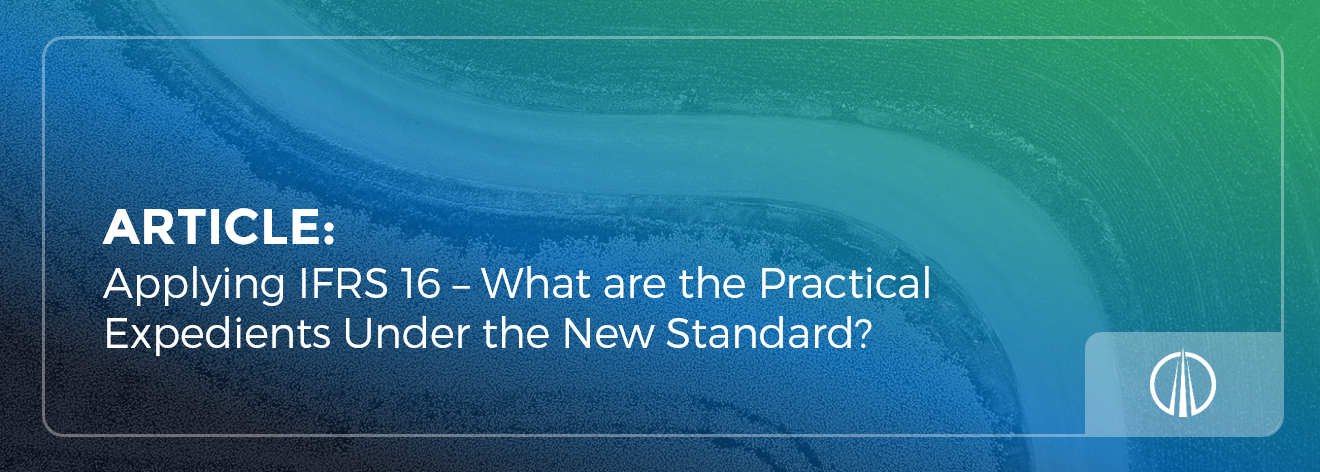Applying IFRS 16 – What are the Practical Expedients Under the New Standard?
Updated 12th May 2021 | 5 min read Published 4th September 2018

For annual accounting periods from January 1st, 2019 IFRS 16 replaces IAS 17 and its associated interpretations. This new standard, just like IAS 17 before it deals with the accounting treatment of leases, but it is fair to say in a more prescriptive manner than just setting out guidelines to be interpreted.
Accounting standards are continually being reviewed, clarified and replaced and the approach to the introduction and deployment of such new standards has resulted in increased consistency with the application of each. More recently the advent of new standards saw this in the “Conceptual Framework’s” requirement for costs imposed and recognised on preparers, regarding time and effort, having to be reflected in the benefits to users. This is evidenced in IFRS 15 by the ability to bundle similar service contracts into a single portfolio assuming that this would not result in any material misrepresentation or distortion of the financials relating to the contracts.
A similar approach is seen in the deployment of IFRS 16 and the practical expedients available under the standard. There are two ways of transitioning to the new standard and these approaches are generally referred to as:
- Fully Retrospective
- Modified Retrospective
Practical expedients are available, especially when following the Modified Retrospective Approach.
Treatment of Initial Direct Costs
An expedient that is particularly useful when records of the assets associated with operating leases are lost or sketchy at best. Under this expedient, any such cost can be treated as “forgotten or ignored” rather than adding it to the carrying value of the right of use asset. As well as helping to expedite the transition of the operating lease to its new treatment by the reduced research needed, it also has the benefit of the resultant reduction in depreciation over the future periods. There is also a reduction in the likelihood of impairment of the asset (this is where the asset market value is less than its “book” value).
Leases Expiring within 12 Months of IFRS 16 Adoption
Another expedient that cuts down on the initial workload associated with the transition is that any lease with an end date scheduled within the next 12 months can be expensed on a straight-line basis through the profit and loss account in the same way as short-term leases initiated after the 1st January 2019. The one difference is that this expedient cannot be applied lease by lease (as is the case with actual short-term leases) but must if adopted be applied to all leases with assets of a similar class.
Discount Rate Application
Staying with the theme of avoiding unnecessary time and effort in the transition to IFRS 16 there is a useful expedient regarding the discount rate options to be applied. Rather than attempting to quantify the discount rate applicable to a particular lease, the lessee is able to apply a single rate to any and all leases with similar assets, similar end dates and in similar economic environments. For more information on this subject please refer to Innervision’s Blog “Applying IFRS 16 – Determining the Appropriate Lease Discount Rate”.
Separating Out Non-Lease Components
An operating lease under IAS 17 may have had asset and service components and both parts would have been expensed. Separating them out will be a requirement of the new standard with the asset being capitalised whilst the service element will be likely expensed. IFRS 16 again makes available an expedient to ease the transition in that the lessee may elect any existing lease comprising both components to be treated as a lease. Where there is no significant service element this will undoubtedly appeal and any additional cost in amortisation and lease liability will be offset by the reduced effort in transitioning the lease to IFRS 16 – see Blog “Applying IFRS 16 – Separating Lease Components”.
Application of Hindsight
Again reflecting the concern of the IASB to keep things simple and to ease transition, a lessee adopting the modified retrospective approach can opt to treat a right of use asset as if IFRS 16 had always been applied but using the incremental borrowing rate at the date of application so negating the requirement to reconstruct the lease to allow for any extensions, modifications or termination options.
Expedients beyond Transition
The IASB has in line with IAS 8 (Accounting Policies, Changes in Accounting Estimates and Errors) applied materiality to parts of IFRS 16 such that leases of less than 12 months may be expensed. A lessee can treat any lease for an asset of low value (there is a guideline of $5,000) in a similar fashion. Though materiality is not defined, “The Conceptual Framework and IAS 1 Presentation of Financial Statements” does give guidelines. For more detail on these expedients, you should refer to “Applying IFRS 16 – Areas of the New Standard Requiring Significant Judgement”
As you progress through transition and begin full-scale adoption of IFRS 16 other expedients may be brought to your attention by the IASB, your auditors or indeed a blog similar to this but the 6 listed above if applied where sensible or necessary will result in a smoother, less taxing, less resource intensive implementation of the new lease accounting standard for your business and the associated people.
Having a comprehensive understanding of the new standard and the various transition options and practical expedients available will play a vital role when making considered business decisions when implementing IFRS 16. If you’re looking for further guidance on how to effectively transition to the new standard, or if you have any other questions around how it could impact your organisation, download our free guide, ‘The 7 Steps to Lease Accounting Compliance’ – just follow the link below to access your copy.
Disclaimer: this article contains general information about the new lease accounting standards only and should NOT be viewed in any way as professional advice or service. The Publisher will not be responsible for any losses or damages of any kind incurred by the reader whether directly or indirectly arising from the use of the information found within this article.

